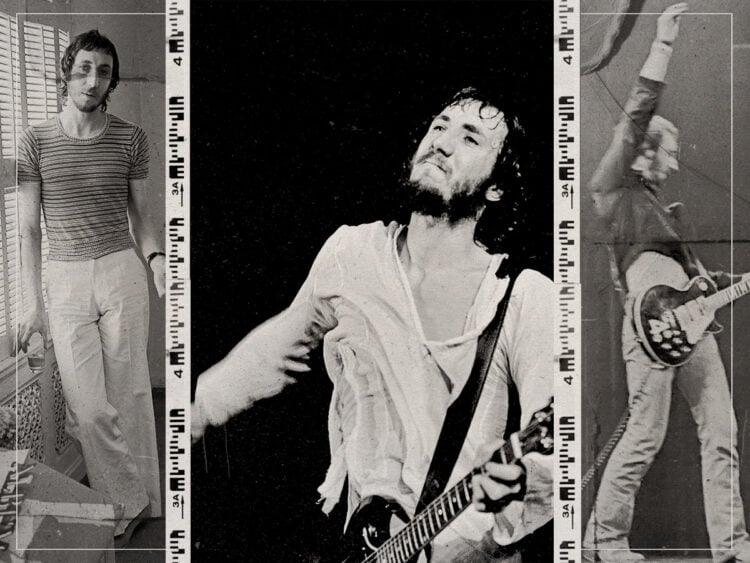Pete Townshend's 10 Greatest Songs: A Definitive List

Table of Contents
The Who's Early Classics: Raw Power and Teenage Angst
This period established The Who's sound and Townshend's songwriting prowess, defining a generation's rebellion. These early classics are characterized by their raw energy and relatable lyrics about teenage angst and societal pressures.
"My Generation" (1965):
- Innovative use of feedback: Townshend's pioneering use of feedback guitar became a defining element of the song and heavily influenced subsequent rock musicians.
- Iconic opening riff: Instantly recognizable and instantly memorable, this riff is one of the most influential in rock history.
- Socially conscious lyrics: The lyrics addressed the frustrations and alienation of the youth of the 1960s, making it an anthem for a generation.
- Impact on youth culture: The song's rebellious energy resonated deeply with young people, further solidifying its status as a generational touchstone.
The impact of "My Generation" extended far beyond its initial release. It's been covered countless times and remains a staple of rock radio and live performances to this day. Its influence can be heard in the work of countless artists who followed.
"Substitute" (1966):
- Catchy melody: Despite its raw power, "Substitute" boasts an undeniably catchy melody that makes it instantly memorable.
- Powerful vocals: Roger Daltrey’s powerful vocals perfectly complement Townshend’s energetic guitar work.
- Relatable lyrics about identity and societal pressures: The lyrics explore the feelings of being an outsider and struggling to find one's place in society.
The unique rhythmic structure of "Substitute" sets it apart from many of its contemporaries. Its commercial success cemented The Who's place in the music industry.
"I Can't Explain" (1965):
- Minimalist approach: The song's simplicity belies its emotional depth, showcasing Townshend's ability to create powerful music with minimal instrumentation.
- Raw emotion: The raw emotion in both the music and vocals is palpable, conveying a sense of youthful frustration and longing.
- Influence of R&B and early rock and roll: The song's influences are clear, blending elements of R&B and early rock and roll into a unique sound.
"I Can't Explain" played a crucial role in launching The Who's career, establishing their distinctive sound and paving the way for their future successes.
Exploring Deeper Themes: Social Commentary and Personal Reflection
As The Who matured, so did Townshend's songwriting, delving into more complex themes of social commentary and personal reflection. These songs showcase his growing musical ambition and lyrical depth.
"A Quick One, While He's Away" (1966):
- Complex storytelling: The song is a mini-opera, telling a complex story with multiple characters and plot lines.
- Orchestral arrangements: The inclusion of orchestral arrangements demonstrated Townshend's growing ambition and willingness to experiment with musical forms.
- Innovative use of musical dynamics: The song effectively uses dynamic shifts to heighten the emotional impact of the storytelling.
- Concept album influence: This song foreshadowed the concept album format that would become increasingly popular in the years to come.
The narrative complexity and musical innovation of "A Quick One, While He's Away" marked a significant step forward in Townshend's songwriting.
"Baba O'Riley" (1971):
- Use of synthesizers: The song's prominent use of synthesizers was groundbreaking for its time, influencing countless artists who followed.
- Memorable riff: The iconic opening riff is instantly recognizable and has become a staple of rock music.
- Driving rhythm: The song's driving rhythm is both infectious and powerful.
- Spiritual themes: The lyrics explore themes of spirituality and the search for meaning.
"Baba O'Riley" remains one of The Who's most popular and enduring songs, a testament to its innovative sound and timeless appeal.
"Won't Get Fooled Again" (1971):
- Powerful vocals: Daltrey’s vocals are particularly powerful on this track, conveying the song's message with raw intensity.
- Anthemic chorus: The anthemic chorus is both memorable and emotionally resonant.
- Complex arrangements: The song's complex arrangements and powerful dynamics showcase Townshend’s masterful command of musical composition.
- Philosophical lyrics: The lyrics explore themes of societal disillusionment and the cyclical nature of history, making it highly relevant even today.
The political and social undertones of "Won't Get Fooled Again" continue to resonate with listeners, ensuring its lasting relevance.
Later Works: Evolution and Continued Innovation
Even in his later career, Townshend continued to evolve as a songwriter, exploring new sounds and expressing a wider range of emotions.
"Let My Love Open the Door" (1982):
- Acoustic guitar: The song's prominent use of acoustic guitar creates a more intimate and reflective atmosphere.
- Melancholic melody: The melancholic melody adds to the song's emotional depth.
- Emotional lyrics: The lyrics are deeply personal and emotionally resonant, showing a softer side of Townshend's songwriting.
- Departure from his earlier rock sound: This song represents a departure from his earlier, more aggressive rock sound, showcasing his versatility.
The vulnerability and intimate atmosphere of "Let My Love Open the Door" are a testament to Townshend's evolving songwriting style.
"Behind Blue Eyes" (1971):
- Haunting melody: The haunting melody is both beautiful and emotionally evocative.
- Heartfelt lyrics: The lyrics explore the pain of unrequited love and the struggle to express one's emotions.
- Raw emotion: The raw emotion in both the music and vocals is undeniable, making the song deeply moving.
- Vulnerability: The song showcases a vulnerability rarely seen in Townshend's earlier work.
Despite being a Who song, "Behind Blue Eyes" highlights Townshend's ability to craft emotionally resonant lyrics with universal themes.
"Eminence Front" (1982):
- Complex composition: The song is a complex composition, showcasing Townshend’s continued skill in crafting intricate musical arrangements.
- Blending rock and synth elements: The song effectively blends elements of rock and synth-pop, demonstrating Townshend's willingness to experiment with different musical styles.
- Lyrical imagery: The lyrics are rich with vivid imagery and metaphors, adding to the song's overall impact.
"Eminence Front" is a powerful showcase of Townshend's enduring creative energy and ability to adapt to changing musical landscapes.
Conclusion:
This exploration of Pete Townshend's greatest songs reveals his extraordinary talent and lasting influence on rock music. From the youthful energy of "My Generation" to the introspective depth of "Let My Love Open the Door," his compositions consistently challenge, provoke, and inspire. Whether you're a longtime fan or new to the music of The Who, this list serves as a gateway to understanding the genius of Pete Townshend. Explore his diverse catalog further and discover your own favorite among Pete Townshend's greatest songs!

Featured Posts
-
 Vanja Mijatovic Potresna Ispovest O Razvodu I Borbi S Medijima
May 23, 2025
Vanja Mijatovic Potresna Ispovest O Razvodu I Borbi S Medijima
May 23, 2025 -
 Zimbabwe Vs Bangladesh Muzarabanis Bowling Dominance Secures Historic Test Win
May 23, 2025
Zimbabwe Vs Bangladesh Muzarabanis Bowling Dominance Secures Historic Test Win
May 23, 2025 -
 Macaulay Culkin And Kieran Culkins Mothers Financial Struggle
May 23, 2025
Macaulay Culkin And Kieran Culkins Mothers Financial Struggle
May 23, 2025 -
 Manchester United Transfer News Ten Hags Future Uncertain Amidst Leverkusen Links
May 23, 2025
Manchester United Transfer News Ten Hags Future Uncertain Amidst Leverkusen Links
May 23, 2025 -
 Vybz Kartel Sold Out Shows In Brooklyn Deliver Unforgettable Performances
May 23, 2025
Vybz Kartel Sold Out Shows In Brooklyn Deliver Unforgettable Performances
May 23, 2025
Latest Posts
-
 Manchester United Manager Lauds Arsenal Defenders Performance
May 23, 2025
Manchester United Manager Lauds Arsenal Defenders Performance
May 23, 2025 -
 Man Uniteds Setback Stams Verdict On Ten Hags Transfer Policy
May 23, 2025
Man Uniteds Setback Stams Verdict On Ten Hags Transfer Policy
May 23, 2025 -
 Erik Ten Hag On Arsenals Defensive Star Post Real Madrid Match Comments
May 23, 2025
Erik Ten Hag On Arsenals Defensive Star Post Real Madrid Match Comments
May 23, 2025 -
 Is Noussair Mazraoui Manchester Uniteds Best Transfer In Years A Detailed Analysis
May 23, 2025
Is Noussair Mazraoui Manchester Uniteds Best Transfer In Years A Detailed Analysis
May 23, 2025 -
 Arsenal Defender Earns Ten Hags Respect A Soldier On The Pitch
May 23, 2025
Arsenal Defender Earns Ten Hags Respect A Soldier On The Pitch
May 23, 2025
